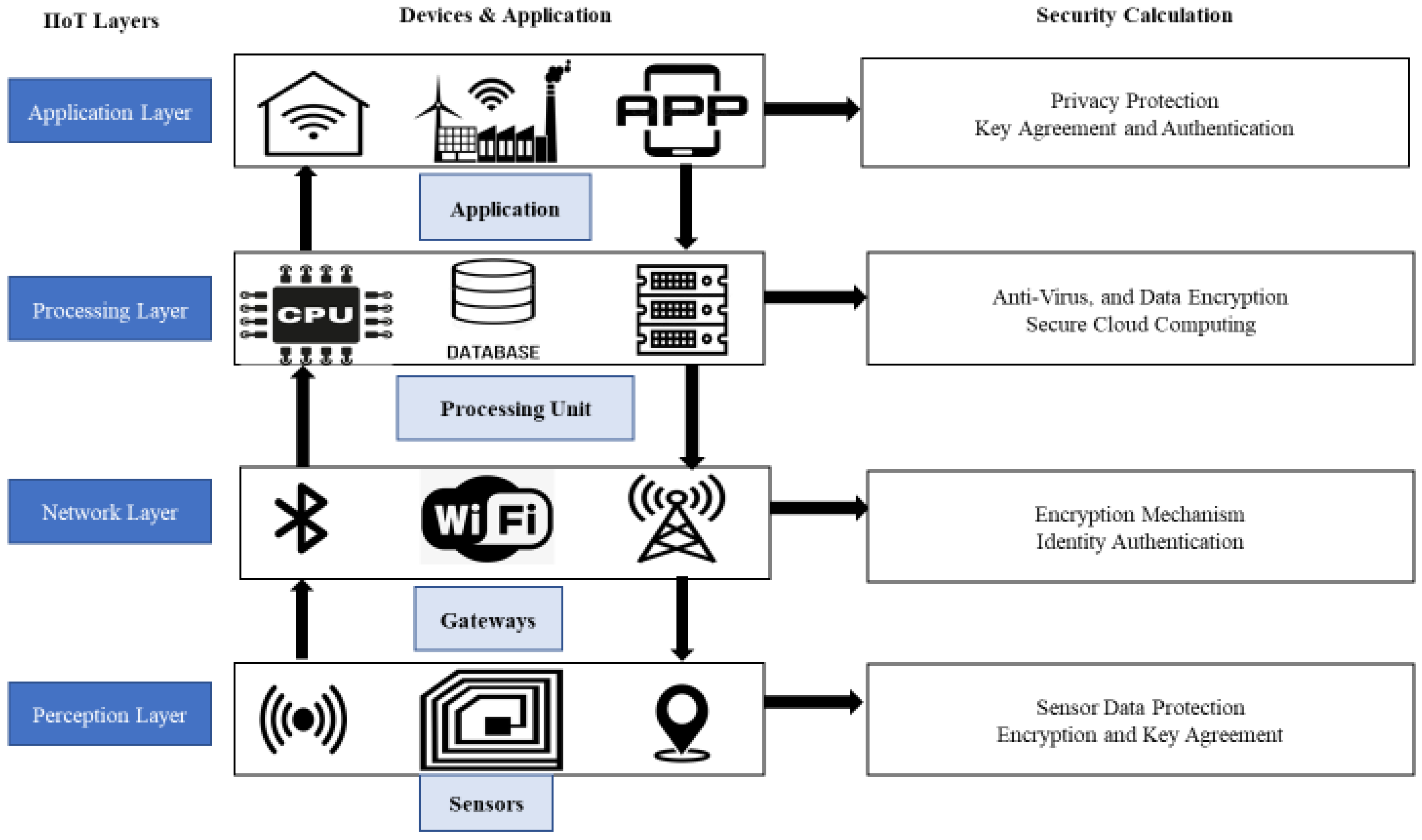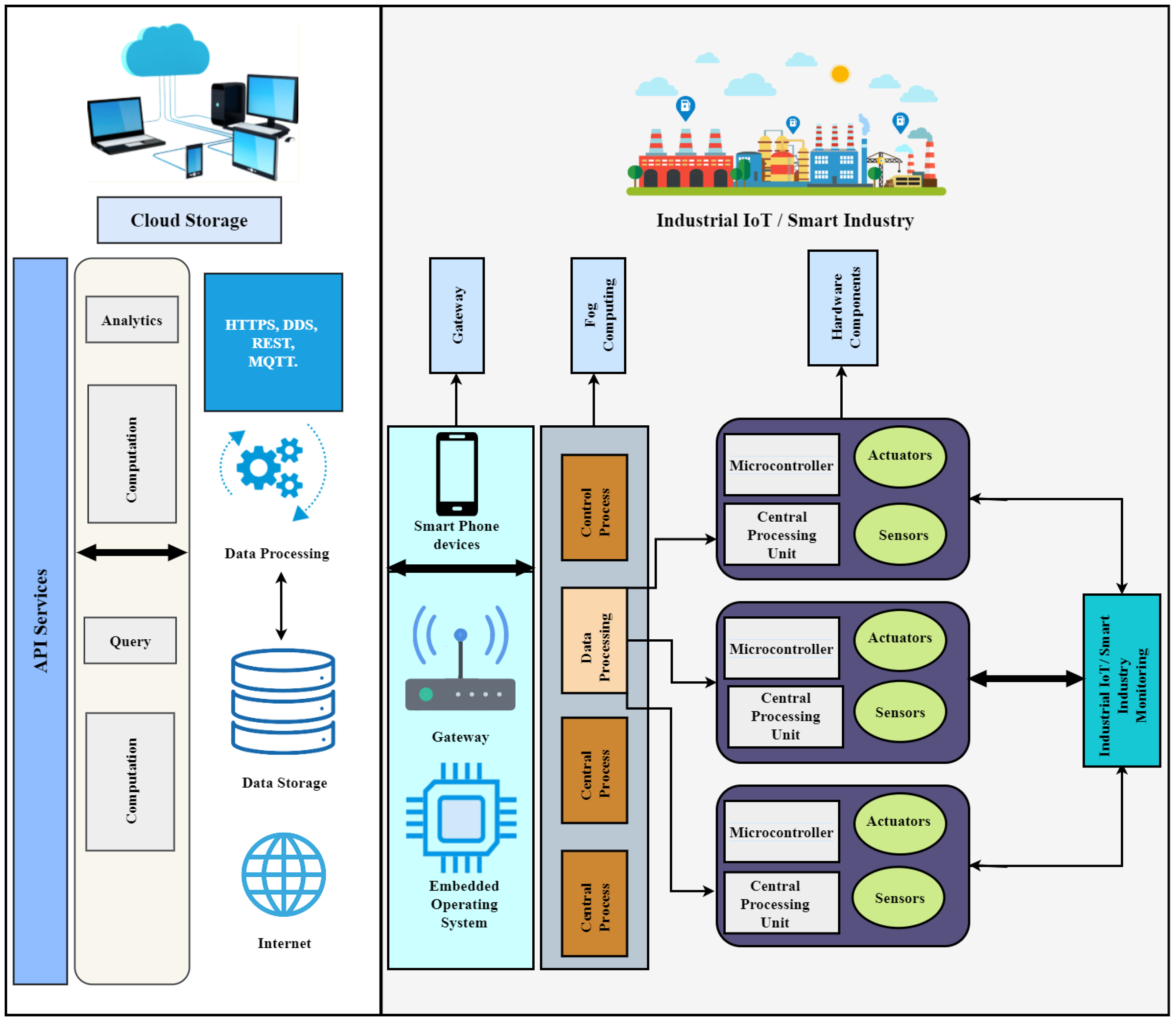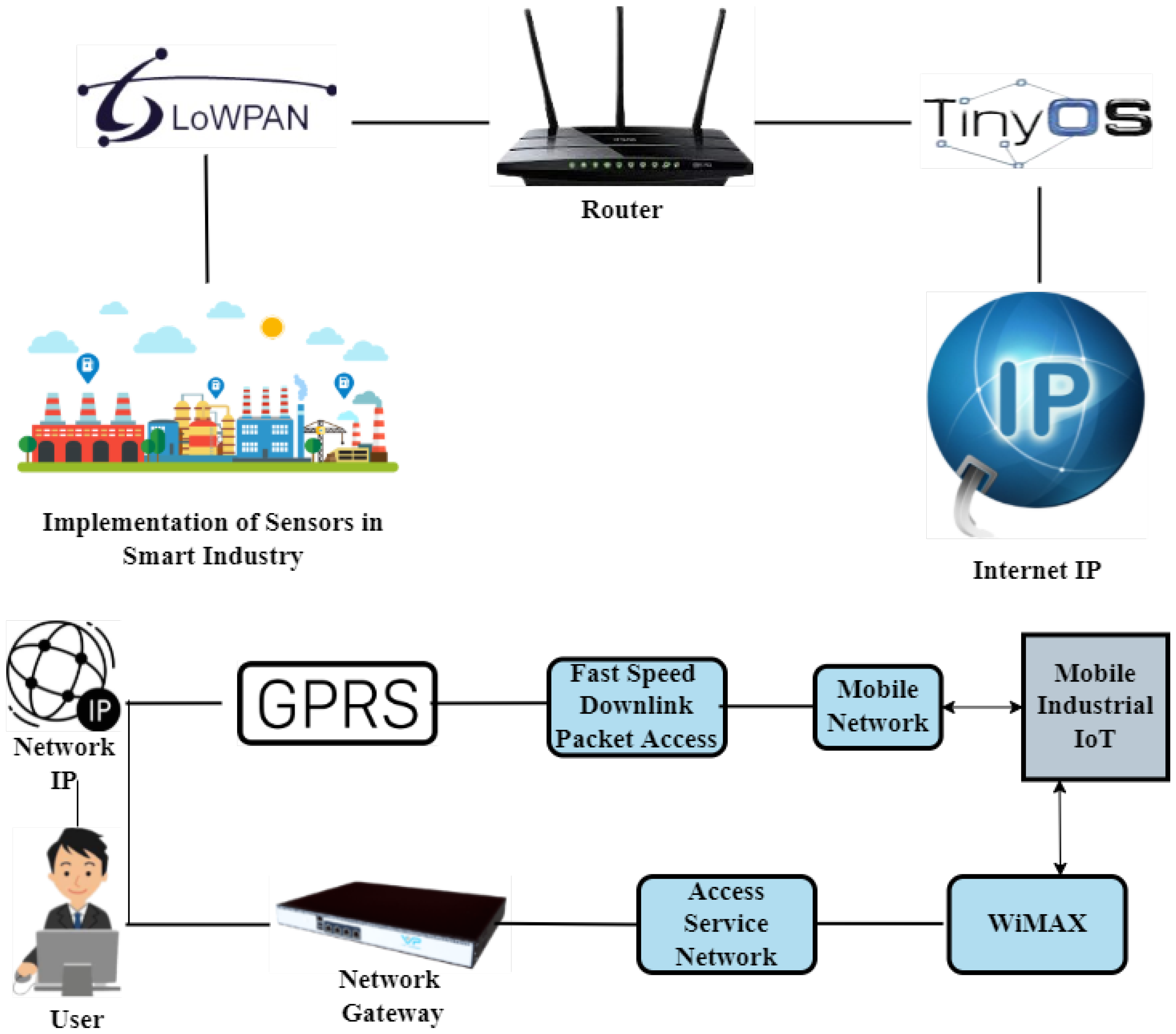1. Layered Structure of IoT-Enabled Industrial Network Architecture
The most important aspect of IIoT is the IIoT network, which connects devices, actuators, sensors, processors, cyber-physical systems, and production flow to make smart decisions
[1]. The three-layer architecture, including the network layer, the perception layer, and the application or support layer, was initially presented by the researchers
[2][3]. However, the three-layered architecture is weak from a security perspective and unable to fulfill the IoT network requirements
[4]. For example,
[3][4] points out several attacks on IIoT and various other security weaknesses. For that reason, the three-layer architecture has been shifted into a four-layer infrastructure (the perception layer, the network layer, the application layer, and the processing layer) to enhance the security of IoT networks
[5]. After a comprehensive study of these four layers, two more solutions are IPv6 and 6LoWPAN, as shown in
Figure 1. The support layer is the last stage of abstraction in the network architecture, which makes it more secure and robust. At this stage, communication protocols are used to keep track of several smart industry characteristics, like energy usage, cost reduction, and productivity enhancement. The network architecture includes sensors/devices at the first layer, communication devices at the second layer, data processing and storage at the processing layer, and smart applications at the fourth layer, as shown in
Figure 2.
Figure 1. The 6LoWPAN layer structure.
Figure 2. IIoT four-layer architecture.
1.1. Perception Layer
The perception layer is also defined as the sensor layer. It is a mixture of sensor and physical devices, global positioning system (GPS) modules, RFID, 2-D barcode, and closed-circuit television (CCTV) cameras
[2]. It gathers data from all connected devices and sends them to the servers. In the industrial environment, devices are responsible for transporting raw items, monitoring production areas, and catching sensory data, industrial robots, automated guided vehicles (AGVs), and transporter systems. It is a sensitive layer and can be attacked easily. The security threats for the perception layer include node injection, tampering, eavesdropping, reply attacks, radio frequency (RF) interference, timing attacks, and node capturing
[6].
1.2. Network Layer
The network layer, also called data transmission, is responsible for receiving and transferring industrial information between physical objects, smart things, devices, sensors, networks, and servers using a wired or wireless medium
[3]. It consists of protocols like IPv4, IPv6, WiFI, ZigBee, etc., and helps the connection between the perception (or sensor) layer. As a result, the network layer is susceptible to various attacks. Man-in-the-middle attacks (MITM), Sybil attacks, spoofing, denial of service (DoS), and sinkhole attacks are the riskiest and most well-known attacks on the network layer
[6].
1.3. Application Layer
The application layer is responsible for transferring IIoT applications from a connected device to the user. It works as a bridge between the end nodes and the network of IIoT, allowing them to communicate with approved software components
[4]. The smart home, smart factory, and smart robotics are famous IIoT applications
[7]. Securing the application layer is extremely challenging as security is a critical issue. Smart home applications are fragile to security issues because they are insecure from the inside and outside, which can introduce vulnerabilities. The security attacks on the application layer can be Trojan horses, malicious code attacks, cross-site scripting, and side-channel attacks
[8].
1.4. Processing Layer
The main reason for creating the fourth processing (or support layer) layer is various security issues in different layers of IIoT. The three-level architecture is not secure enough to pass data directly to the network layers; this layer overcomes multiple threats. The fourth-level architecture was proposed to overcome security issues in IIoT. Authentication is prioritized using passwords, pre-shared secrets, and keys and then sending collected data to the network layers. It contains databases and servers that can run various tasks like decision-making, storing vast amounts of data, and computer algorithms
[9].
2. IoT-Enabled Industrial Network Platform
Big data analytics and cloud models have been included in the IIoT network platform.
2.1. IIoT Network Platform Based on Big Data Analytics
Big data analysis collects essential and useful information from massive data and various types of data. The increasing deployment of sensors and IoT devices has resulted in a big data source in the IIoT. In IIoT systems, big data analytics is utilized for both functional and customer data. The big data-based IIoT network platform is shown in
Figure 3. It is divided into six parts: big data analysis, employee experience, storage devices, monitoring and sensing, communication protocols, and physical implementation. This platform allows users to connect to the IoT backbone and collect data on equipment’s health monitoring, indoor climate, miniaturization, manufacturing process automation, etc.
[10].
Figure 3. IIoT network-based platform on big data analytics.
-
Employee’s Experience: The employee experience layer is created to benefit employees by monitoring equipment health and identifying temperature, humidity, air, pressure, and moisture-based indoor climate change. This identification helps industries to resolve production risks and increase income.
-
Predictive Analysis: Predictive analysis uses smart IIoT technology and market intelligence to make a smart environment. The key role of predictive analysis is to monitor, examine, and progress smart industrial technology for digital wakefulness. In addition, predictive analysis is used to check if the manufacturing process is working in the right direction without technical faults and risks. Based on manufacturing process management, different detection devices are used to identify indoor climate changes, equipment health, profit/loss estimation, and data analysis.
-
Sensing and Monitoring Analysis: The sensing and monitoring process is performed using various sensing and detecting equipment to store information about the manufacturing process. The sensing layer automatically analyzes the data collected from different resources. In addition, statistical analysis is performed on data received from sensors to actuate the production risks. Sensors such as vibration sensors, air sensors, temperature sensors, current monitoring, and humidity sensors provide crucial data regarding production units and help the smart industry run smoothly.
-
Storage Service: The data related to the smart industry are saved to perform future analyses to enhance manufacturing productivity appropriately.
-
Communication Protocols: Smart industrial data are collected and summarized in communication protocols. Therefore, the central pillar of IIoT analyzes and transmits data using different protocols. Third-party service providers like code division multiple access (CDMA), long-term evolution (LTE), or the global system for mobile communications (GSM) are no longer available. Researchers across the globe recommend ZigBee as the leading protocol for communication over long distances.
-
Physical Implementations: Several sensors, actuators, and microcontrollers monitor various IIoT applications. In addition, additional devices in the network such as routers, switches, and gateways are major components of the physical layer. This layer detects the whole environment and activates according to specified commands. The microcontroller works as a controller and performs network-related tasks and other functions handled by sensors and actuators.
2.2. IIoT Network Platform Based on Cloud Computing
Cloud computing delivers a huge amount of storage via large virtualized computers linked together. In addition, cloud computing and big data consist of the latest high-performance computing, IIoT technologies, service-oriented technologies, and cloud services
[11].
Figure 4 shows the cloud computing-based IIoT network platform with four layers: cloud storage, gateway, fog computing, and hardware modules. The IIoT-related data, including manufacturing processes, indoor climate change, moisturizing, and smart industry marketing, are stored in the cloud. The networked infrastructure provides on-demand resources. In addition, online services and analytical resources are also stored and accessed via cloud computing
[12].
Figure 4. The cloud computing-based industrial IoT network platform.
Connecting a large number of devices to the internet for data sharing is not appropriate or safe. Instead, local gateways are designed to solve data-sharing problems by connecting all hardware devices and sensors for security, connectivity, and controllability. For example, a gateway in a production process or productivity unit controls a real-time manufacturing monitoring system and enhances automation. Similarly, fog computing allows the distribution of hardware components, cloud services, and the combination of available resources
[13]. In addition, fog computing ensures real-time processing and reduces cloud computational load. The main objective of fog computing is to take advantage of both edge and cloud computing to maximize cloud computing resources and on-demand scalability.
Multiple sensors, actuators, microcontrollers, and a central processing unit are applied to components to sense and monitor different IIoT variables. Hardware components are delivered worldwide or locally and utilized to provide services or processes. A fast response time and the ability to exchange information are required for smart manufacturing deployment. MQTT and representational state transfer (REST) are two protocols that meet both the requirements of a quick response time and the ability to communicate information. Using a big data center, a distributed system is made more efficient for smart manufacturing
[14]. It also divides large computations into simple and smaller jobs, such as controlling temperature, floor moisture, indoor climate, and production units.
3. IoT-Enabled Industrial Network Topology and Protocols
An IIoT network’s topology describes how different network elements of the IIoT are connected and provides an ideal smart industry scenario. Several IoT connection protocols are commonly used in the industrial field for the smart industry
[15]. Using these protocols, employees/workers can communicate more easily and make effective decision-making for the smart industry to improve and monitor the manufacturing productivity of the unit.
3.1. IoT-Enabled Industrial Network Platform
IIoT network topology provides a state-of-the-art network topology for the smart industry. IIoT network topology combines different sensors, actuators, and physical devices like pressure, temperature, humidity current monitoring, vibration, and water detecting sensors, as depicted in
Figure 5. Moreover, the ideal scenario (conceptual design) for future smart industry solutions includes the help of storage devices such as laptops, tablets, smartphones, grid computing, and actuators
[16].
Figure 5. Conceptual designfor smart industry.
A structural framework of IIoT network topology is given in
Figure 6. The production unit and manufacturing sector are monitored with the help of different protocols and devices. Data from various sensors and devices are useful for aggregated data. Data are then processed and stored. Industrialists/employees can remotely monitor different manufacturing unit aggregations and analyses. Furthermore, topology comprises an appropriate network configuration for industrial video streaming
[17].
Figure 6. Remote monitoring topology in a manufacturing unit of smart industry.
Similarly,
Figure 7 shows an interconnected network comprising internet protocol (IP), GSM, WiMAX, access service network gateway, and manufacturing units. A wireless sensor network is used to monitor (the manufacturing process) and control (power consumption) in many fields of the smart industry. ZigBee is used in network topology; the function of ZigBee is to transfer data or sensitive information through routers, sensors, base stations, and end devices. In addition, sensors like air sensors, temperature sensors, vibration sensors, humidity sensors, current monitoring sensors, and microcontrollers are used
[18]. The router and microcontroller are connected directly to the end devices, and the microcontroller communicates with the base station through the serial port to examine the collected data. According to software monitoring, each end device is configured properly, and attached sensors are enabled. When the sensors are turned on, each device follows the router to connect in the designed way. End devices can connect to the WSN using the same key after validation. Sensor data are sent to the base station, which analyzes the information. Data are transferred through ZigBee to the controller or router when end-device sensors are read. The bidirectional communication via ZigBee is the main strength of this network topology.
Figure 7. Low-power wireless sensor network topology.
3.2. IIoT Communication Protocols
Various IoT communication protocols have been widely used in the smart manufacturing industry. Therefore, it is very useful to use smart manufacturing and monitor the rise in industry productivity by employing these protocols
[15]. The most popular wireless protocols are ZigBee, Bluetooth, WiFI, MQTT, Lora WAN, mobile cellular networks, RFID, WiMAX, and LR-WPAN.
Table 1 provides a summary of wireless protocols utilized in IIoT communication. These protocols are discussed from several aspects. For example, protocols are described with respect to operating frequency, IEEE standard, and transmission range. In addition, data rate, cost, and energy usage are also given. LoraWAN and WiMAX are better choices for long-range communication, but LoraWAN consumes less energy compared to WiMAX.
Table 1. Comparison between current wireless protocols.
-
ZigBee: ZigBee technology is a low-data-rate, low-power consumption, and low-cost wireless networking protocol developed by the ZigBee Alliance for automation and sensor networks. The ZigBee network can contain many nodes in an industrial environment and connect them into a single control network
[19].
-
Bluetooth: Bluetooth is a low-power, short-range personal area network (PAN). It was developed by Ericson but operated under the auspices of the Bluetooth special interest group (SIG), which created the Bluetooth standards (IEEE 802.15.1). Moreover, to close the energy efficiency gap between Zigbee and Bluetooth for no-streaming sensor node-type applications, the low energy standard for IIoT-based Bluetooth has been modified
[20].
-
WiFi: In the current era of modern advancements, the availability of WiFi has become a necessity. WiFi stands for wireless fidelity, and was introduced by the Institute of Electrical and Electronics Engineers (IEEE) and is a communication standard for wireless local area networks (WLANs). WiFi operates on physical and data link layers. Furthermore, these standards operate at different bandwidths, ranging from 5 GHz to 60 GHz. The communication and manufacturing processes are discussed in
[21].
-
MQTT: MQTT is a remote connection between two messages queuing telemetry transport protocols in the IoT. It is a combination of low-power protocols with high bandwidth efficiency. In the smart manufacturing industry, MQTT is utilized for monitoring and development. The use of MQTT to track, monitor, and investigate the manufacturing process and improve efficiency has been presented as a low-cost, web-based IoT solution
[22].
-
Lora Wan: Lora WAN is a long-distance communication protocol designed for IoT and mobile-to-mobile (M2M) applications that provide a cellular-style, low-data-rate communications network. The primary goal of the Lora WAN protocol is to ensure interoperability across several operators in the IIoT
[23].
-
Mobile Cellular Networks: There are many generations of mobile communication standards, including 2G, 3G, 4G, and 5G. Each generation of mobile phones has its own challenges and capabilities. For example, smart manufacturing based on cyber-physical manufacturing systems helps IIoT in automation, real-time monitoring, and collaborative control. Although 3G and 4G cannot meet the CPMS standard requirements, 5G can support IIoT
[24].
-
RFID: RFID records data by assigning a unique number to each object. RFID systems comprise readers, hosts, and tags that receive and broadcast radio waves, also known as the communicators. RFID tags can be active or passive, and they come in a range of sizes and designs. Passive tags are less expensive than active tags and are more profitable. Tags have unique ID numbers and IIoT environmental information, such as moisture level, temperature condition, humidity, etc. In the IIoT, RFID monitors the manufacturing process
[25].
-
WiMax: The data transfer rate of WiMAX ranges from 1.5 Mb to 1 Gb per second. However, technical advancements have improved the data transfer rate in recent years. Furthermore, WiMAX offers multi-access connectivity, including wired and wireless connectivity for fixed, mobile, portable, and mobile communication, used in IIoT
[26].
-
LR-WPAN: In recent years, advancements in high-level communication protocols such as ZigBee have developed low-rate wireless personal area network (LR-WPAN) standards. LR-WPAN offers data rates ranging from 40 to 250 Kb per second. This standard’s key feature is that it delivers low-speed and low-cost communication services. It has a frequency band that ranges from 868/915 MHz to 2.4 GHz. LR-WPAN has been used in IIoT control applications and manufacturing monitoring systems
[27].












